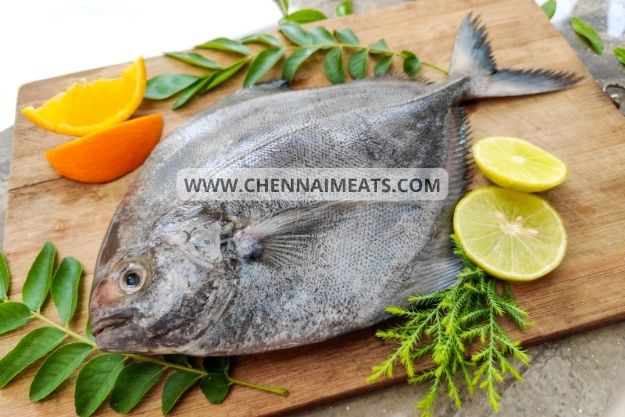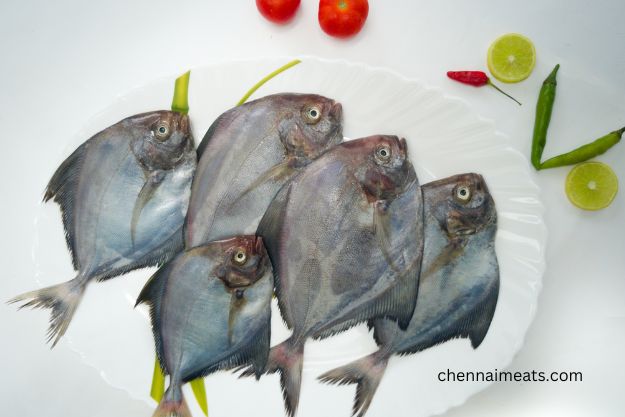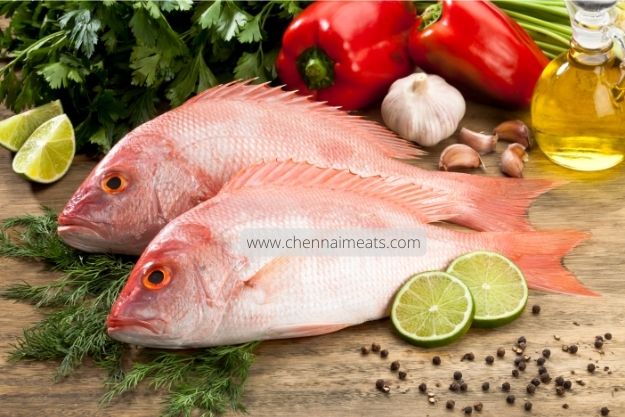| +(91) 9940 284 282 | Preorder before | 12 Midnight |
| [email protected] | Delivery Time | 7 AM to 11 AM |
| +(91) 9940 284 282 | Preorder before | 12 Midnight |
| [email protected] | Delivery Time | 7 AM to 11 AM |



The Black Pomfret, also known as Halwa Fish, is a high-protein, omega-3-fatty-acid-rich fish. Order your pre-cleaned and gutted Black Pomfret Steaks online, which are also sliced perpendicular to the spine and arrive with the skin intact. One of the fleshiest cuts of this fish, these steaks have a delicate flavor and a firm texture and can be purchased at Chennai Meats. You can order this fish from Chennai Meats and get it delivered to your home. They're great for pan-frying or baking.
₹390 ₹546 Save 25% Offer
This Indo-West Pacific fish is found from Australia's north coast to southern Japan and Africa to Borneo. The black pomfret has a compressed deep body with equally convex dorsal and ventral profiles. The entire body of this species is covered with tiny dark grey scales. The average length of a Black Pomfret fork is 30 cm, although it may be as long as 75 cm. It usually grows up to 29 inches long, bringing it closer to the massive size seen in markets. Despite its great commercial value, this is a fast-breeding fish not considered endangered.
This fish has light-colored meat with a mellow but not dull flavor. There is a black strip beneath the skin, but it has no real taste advantage over the light meat. The meat keeps together nicely in wet cooking and pan-frying, although it flakes readily on the plate. It's a delicious fish for baking or steaming whole or pan-dressed since the skin shrinks slightly. It's an excellent form for whole-food cooking.
Purchasing: These fish can be found in abundance in Asian markets. There are two main sizes available: 8 to 11 inches and 5 to 7 inches. The larger ones are usually kept on ice or frozen in foam trays, while the smaller ones are frozen in bags.
Scales: Black Pomfret is entirely coated in small scales that adhere to the skin with significant adhesion. With only minimal flying around, they peel off quite easily.
Cleaning: Karuppu Vavaal is slightly different from most firm keels because the keel does not extend forward. To make cleaning easier, cut the head off (make incisions around the collar, then cut the backbone from the side) if you don't intend to cook it head-on.
If you want to cook the fish head-on, as is typically the case, you may do so that you get a fish with two nice sides; as with Cleaning and Filleting a Round Fish, cut the vent to beneath the chin. Then, using your long nose pliers, take out the gills. It will loosen the innards sufficiently for you to hook them out partially with a finger and then complete with the pliers. A tiny amount of soft material will remain in the chamber aft of the vent on each side of the keel, but you may scoop it out with your finger.
Fillet: With a consistent and simple-to-follow fin/bone structure. Cut through the skin on top and bottom to outline the fillet. From front to tail, cut down to the backbone, then over the tail and forward. You may either remove the fillet from the ribs or cut it from the backbone with kitchen shears and pull it off the fillet when you reach the rib cage. If you're using skin-on fillets, remove the hard skutes except for the straight area towards the tail. Long centerline pin bones that run the length of the body cavity must be pulled. You can still feel them further back, but they'll vanish quickly.
Skin: The flavor of the skin is greater than that of the flesh, but it is mild and does not shrink much. As a result, it's ideal for skin-on pan-frying, baking, poaching, or steaming whole. When poached, a skin-on fillet will curl slightly but not nearly as much as other fish. However, because the skin adheres to the meat firmly, removing it with a large knife and cutting board takes more care and effort than other fish. To avoid cutting the skin, hold the knife blade at a very shallow angle, almost horizontal, but it will come out with no flesh if done correctly.
Stock: Heads (gills removed and split), bones, fins, and skins form a mild, virtually transparent stock with almost no oil, making it one of the finest for soup. Use your gravy separator to remove any remaining oil.
Nutritional Facts & Values of Black Pomfret Fish:
Several studies have lately shown the health advantages of eating these fish. The health advantages of Black Pomfret fish are listed below:
Top 5 Health Benefits of eating Barracuda
Recipe 1: Black Pomfret Fish Curry/ Kali Paplet Hooman
Are you bored with Fish fry? Let's try out this delicious Balck Pomfret fish curry, a mildly spiced coconut oil-based curry, and relish our taste buds.
To make Karuppu Vavaal Kulambu/Fish Curry, you will need these ingredients:
Instructions to cook Black Pomfret
Step 1: Allow the fish to marinate for 30 minutes with salt, red chili powder, and turmeric powder.
Step 2: Red chilies, coriander seeds, turmeric powder, peppercorns, tamarind, and coconut, together with 12 cups of water, are blended until smooth.
Step 3: In a pan, heat the oil. Cook until the onions are golden brown.
Step 4: Before adding the 12 cups of water, whisk in the paste.
Toss in the fish and simmer for 12-15 minutes over medium heat. Serve with rice or Rotis right away.
With you ordering your delicacies from Chennai Meats, you not ensure one or two but numerous benefits for yourself.

Whether you like a batter-fried meal or a power-packed, classic seafood pleasure rich in herbs, you should try Vanjaram

Sankara has a mellow flavor and a delicate, soft texture, perfect for curries, fried dishes, tawa fry and grilled dishes.

Ideal for skin-on pan-frying, baking, poaching, or steaming whole & is a high-protein, omega-3-fatty-acid-rich fish.

Subscribe to our Newsletter
For regular updates on Weekly Offers & Personalized Offers.